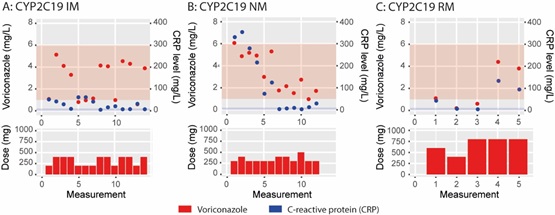Author: Sylvia Klomp, MSc; Jesse Swen, PhD, PharmD on December 11, 2024 
Voriconazole is used to prevent and treat fungal infections following allogeneic hematopoietic stem cell transplantation. CYP2C19 converts it into inactive metabolites. The CYP2C19 gene is genetically polymorphic resulting in five distinct metabolizers phenotypes: poor (2%), intermediate (IM, 23%), normal (NM, 47%), rapid (RM, 26%), and ultra-rapid (2%). Treatment guidelines based on the CYP2C19 genotype are available but are not widely accepted in the clinic since the CYP2C19 genotype only explains a limited part of the intrapatient variability. Recently, inflammation has been described as an important factor for variability in voriconazole pharmcokinetics. We hypothesized that the relation between CYP2C19 genotype and CYP2C19 phenotype changes during inflammation.
In our paper, we show that CYP2C19 activity decreased when inflammation (defined at CRP levels of > 50 mg/L) progressed. All CYP2C19 genotype predicted phenotypes presented in our study are affected, showing phenoconversion to at least one lower CYP2C19 metabolizer phenotype while in inflammation. During inflammation, dose-corrected voriconazole levels increased by 245% for CYP2C19 NMs, 278% for IMs, and 486% for RMs. Consequently, RMs are at particular risk for developing supratherapeutic levels during inflammation when receiving an unadjusted dose.
Our study underpins the importance of regular monitoring of voriconazole levels during changes in inflammation status.

The comment feature is locked by administrator.